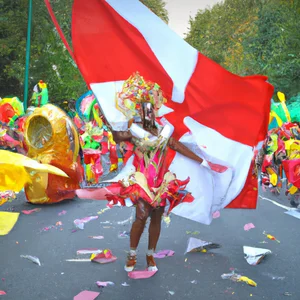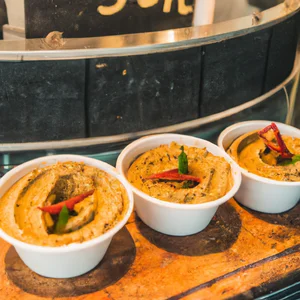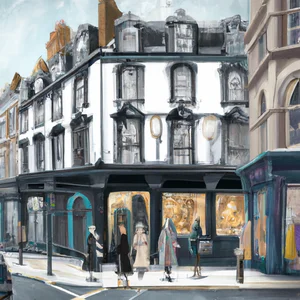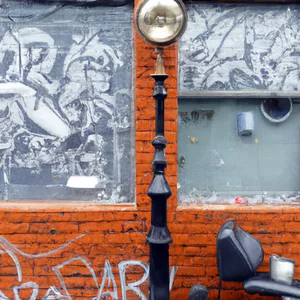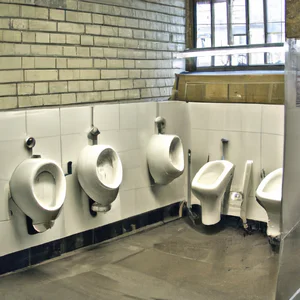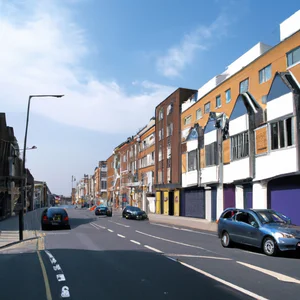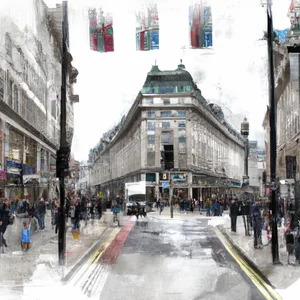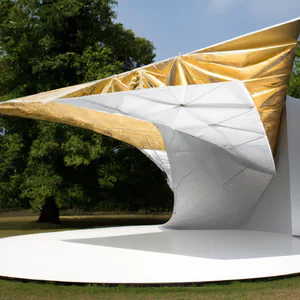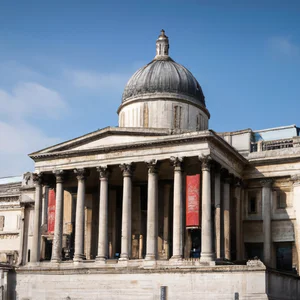Book your experience
London Canal Museum: the history of the canals and the ice trade
The London Canal Museum is a really interesting place, you know? It’s a bit like a time machine that takes you back to when London’s canals were in full swing and ice was a precious commodity. I don’t know if you’ve ever thought about it, but in the 19th century, ice was a real rarity, a luxury for a few. Imagine having to refill your drinks with chunks of ice that arrived from who knows where!
So, this museum tells exactly all of this, the history of the canals and how ice was traded. It’s a fascinating journey that shows you how Londoners have adapted over time - a bit like when you’re trying to find the right way to resolve a tricky situation, right? Lo and behold, the canals were the highways of the time, where barges plied the water to carry ice and other goods around the city.
I remember once, while visiting the museum, I came across some old black and white photos. The images showed men and women loading blocks of ice, and I thought about how tiring it must be. I think, in the end, there’s always a lot of work behind the things we take for granted, like ice in a cocktail, right?
Apart from that, the museum also has a lot of historical objects that tell about life in the canals. The thing that strikes me most is how, despite today’s advanced technology, channels still have their own charm. It’s almost as if they have a personality of their own, a little mysterious and fascinating. After all, who has never dreamed of sailing on a barge, perhaps with a book in hand and a good coffee?
In short, if you are in London and have some free time, I recommend you take a look at this museum. It’s not just a place where you learn things, but it’s also a place where you can reflect on how life has changed, and who knows, maybe go home with some new curiosities to tell. But, I repeat, I don’t know if it’s for everyone, eh! Maybe to some it might seem a little boring, but after all, everyone has their own tastes, right?
Discover the history of London’s canals
A journey through time
I remember the first time I walked along the Regent’s Canal, surrounded by lush greenery and colorful boats floating serenely on the water. As I admired the locks and listened to the sound of flowing water, I wondered how a simple canal could encompass centuries of history and commerce. That walk turned into a deep dive into London’s past, where canals were not just waterways, but vital arteries for commerce and daily life.
The birth of channels
London’s canals, such as the famous Grand Union Canal and the Regent’s Canal, were designed in the 18th century to facilitate the transportation of goods in a rapidly growing city. In an era when roads were often impassable, these waterways became vital to trade, allowing the transportation of building materials, goods, and of course, ice. According to the London Canal Museum, ice was imported from distant sources, such as the lochs of the Scottish Highlands, for use in a variety of industries, from food preservation to the production of refreshing drinks.
An insider tip
A little-known fact is that London’s canals are also historic birdwatching routes. Bring binoculars with you and keep an eye out for the different migratory birds that stop along these waters. It is not uncommon to spot herons and swans moving gracefully between the locks. This will allow you to live a unique experience, far from the hustle and bustle of the city.
A rich cultural heritage
The historical significance of London’s canals cannot be underestimated. They witnessed social and economic changes, helping to shape the city as we know it today. The canals have also inspired artists, writers and musicians, becoming a symbol of tranquility and reflection in the heart of a bustling metropolis.
Sustainability and responsible tourism
As you explore the canals, it is important to adopt sustainable tourism practices. Opt for walking or cycling routes, avoiding boat tours which can disturb the local fauna. Also, bring a reusable bottle with you and stay hydrated with water from available refill points along the route.
Immerse yourself in the atmosphere
Walking along the canals, let yourself be enveloped by the magic of London: the sound of flowing water, the singing of birds and the scent of urban gardening create an enchanting atmosphere that invites contemplation. Every corner tells a story, every bridge a legend.
Activities not to be missed
An unmissable activity is a visit to the London Canal Museum itself, where you can discover more about the history of the canals and the ice trade, with historic artefacts and interactive exhibitions that will take you back in time. If you’re lucky, you might even attend a storytelling event that brings the boatmen’s stories to life.
Myths and reality
One of the common myths is that canals are only for tourists and offer nothing of interest to Londoners. In reality, they are lively and dynamic places, frequented by local artists, markets and festivals that celebrate culture and community.
A new perspective
As you walk along the canals, I invite you to reflect: How has the ice trade, which once seemed so ordinary, helped shape one of the most vibrant cities in the world? Could it be that, in this modern world, there is still much to learn from the history hidden in London’s waters?
The ice trade: a fascinating past
A journey through time between ice and canals
I clearly remember the moment I discovered the fascinating history of the ice trade in London. Strolling along the canals, the sound of flowing water mingled with tales of a bygone era, when ships brought blocks of ice from the Arctic and North American lakes to supply Londoners. Imagine the scene: boats loaded with ice, men at work and the fresh air of a bustling market. These canals, now quiet and characterized by picturesque promenades, once vibrated with the commercial activity that transformed ice into an accessible luxury.
The story behind the ice
The ice trade in London dates back to the early 19th century. Thanks to visionaries such as Frederic Tudor, known as “the Ice King”, blocks of ice were transported all over the world. London became a major distribution center, using its canals to ship fresh ice to restaurants, bars and private homes. This phenomenon has not only revolutionized the way food and drinks are preserved and served, but has also had a significant impact on the city’s eating habits.
An insider tip
A little-known fact is that by visiting the London Canal Museum, you can not only explore the history of ice, but also participate in ice history workshops. These events offer a unique opportunity to interact with experts and discover historical recipes that used ice, an experience few tourists know about.
The cultural impact of the ice trade
Ice has left an indelible mark on London culture. It not only made refreshing drinks and gourmet dishes accessible, but also influenced social life and public events. The introduction of ice allowed the creation of ice creams and desserts, transforming culinary habits and giving life to new gastronomic traditions.
Sustainability and responsibility
Today, sustainable tourism along London’s canals is more important than ever. Many tours offer the option of explore these historic waterways aboard rowboats or canoes, reducing environmental impact and promoting a deeper connection with nature. Choosing to explore the canals responsibly not only preserves the beauty of the place, but also honors the history attached to it.
An experience not to be missed
For an authentic experience, I recommend taking a guided boat tour of London’s canals, where stories of the ice trade are told in an immersive atmosphere. These tours not only offer a unique view of the city, but will also take you to discover historical places linked to this fascinating trade.
Myths and misconceptions
Contrary to popular belief, ice was not just a niche product for the wealthy classes. Thanks to growing demand and the skill of merchants, ice became accessible to all social groups, contributing to the democratization of the consumption of cold drinks.
A new perspective
As you reflect on the history of the ice trade in London, I invite you to consider how this simple element, now so common, has transformed the daily lives of Londoners. What other stories do London’s canals hide? They may reveal surprising aspects of culture and history that remain invisible to the casual eye.
A journey through the locks: unique experience
A memory that flows
I still remember my first encounter with the canal locks of London. It was a spring morning, and the air was fresh and crisp. While walking along the Regent’s Canal, I saw a sightseeing boat approaching a lock. I was about to continue my journey when an elderly boatman, with a friendly smile, invited me to stop and watch the process of opening and closing the lock. That scene, with the water rising and falling, and the sound of the metal mechanisms, transformed a simple moment into a memorable experience.
Practical information
London’s locks, an integral part of the city’s canal network, are not only fascinating from an engineering perspective, but also an opportunity to immerse yourself in British history and culture. The lock system, which dates back to the 18th century, was designed to facilitate waterborne trade. Today, it is possible to visit the most famous locks, such as Little Venice and Camden, which still operate in the traditional way. Boat tours are available, with several companies offering trips along the canal. Visit London and Canal & River Trust are great sources for planning your experience.
An insider tip
A little-known tip is to consider a sunset boat trip. Not only will you avoid the crowds of tourists, but you will also have the opportunity to see the locks illuminated by a warm, golden light, creating a magical atmosphere that you will hardly forget. Also, bring along a small picnic - there’s something really special about enjoying afternoon tea while sailing along the calm waters.
The historical importance of the locks
Locks are not just engineering works; they are a symbol of how London has developed over the centuries. They facilitated the transportation of goods and helped transform the city into a viable commercial center. Their presence tells stories of boatmen and traders, uniting past and present in a way that only canals can.
Sustainability in action
When you explore channels, you can do so responsibly. Tour companies are becoming more aware of the environmental impact and many offer electric or rowing boats as a sustainable option. Furthermore, along the routes of the locks, you will find green areas where you can picnic without leaving any traces. Always remember to bring a reusable water bottle with you and minimize waste.
A dream atmosphere
Imagine sailing along the canals, surrounded by lush greenery and picturesque brick bridges, as the sounds of the city fade into the background. The atmosphere is serene, and each lock becomes a stage for the art of traditional navigation. The bright colors of the boats and the floral decorations of the surrounding gardens create a picture that seems to have come out of an impressionist painting.
An experience not to be missed
I recommend trying a boat tour that includes a passage through the Camden Locks. Not only will you experience the thrill of seeing how a lock works, but you will also have the opportunity to explore Camden Market, famous for its liveliness and culinary offering.
Myths and misconceptions
A common misconception is that locks are only for commercial transportation. In reality, today they are also a place of leisure and exploration. Many Londoners use the canals for walking, jogging or simply enjoying the natural beauty that surrounds these historic structures.
A final reflection
I invite you to consider the importance of these locks not just as a tourist attraction, but as a window into a fascinating past that continues to influence modern life in London. What stories could the waters that flow silently under the bridges tell? A trip to the locks could offer you more than you can imagine.
Sustainability and tourism: explore channels responsibly
A personal experience
I vividly remember the day I decided to explore London’s canals by kayak. The fresh morning air, the sound of gently moving water and the sight of the colorful houseboats dotting the shores made me feel part of something unique and fascinating. But what struck me most was the realization that I was navigating a fragile ecosystem, an ecosystem that demands our attention and respect. Navigating London’s canals is not just a matter of discovery: it is an act of responsibility.
Practical information
Today, sustainable tourism along London’s canals is more important than ever. Several local organizations, such as the London Canal Museum and the Canal & River Trust, offer resources on how to explore these waterways without harming the environment. Before you go, I recommend checking the Canal & River Trust website for events or activities that promote sustainability. Additionally, many kayak or bike rental companies, such as Kayak London and Cycle Hire, are committed to eco-friendly practices, using recyclable materials and promoting clean transportation.
An insider tip
Here’s a little-known tip: bring a trash bag with you when you explore. Not only will you help keep the canals clean, but you will also have the opportunity to meet other sustainability enthusiasts along the way. Often, chatting with other visitors can prove to be an enriching experience, full of stories and suggestions on hidden corners to explore.
Cultural and historical impact
London’s canals are not just waterways; they are a cultural heritage that tells stories of commerce, innovation and community. Their construction in the 19th century transformed the city, making it a center of exchange and interaction. Today, these canals are a symbol of how the city can adapt and respond to modern challenges, including the need for more responsible tourism.
Sustainable tourism practices
When exploring the canals, consider using sustainable transportation, such as bicycles or rowboats, to reduce your environmental impact. Additionally, try to support local shops and restaurants that practice eco-friendly methods and use zero-mile ingredients. This not only enriches the your experience, but also contributes to the local community.
An activity worth trying
If you want a unique experience, take a guided canal cleaning tour. These events, organized by local groups, will allow you to discover the history and biodiversity of the canals while doing your part in their preservation. It’s an activity that not only brings you closer to nature, but also gives you the opportunity to connect with others who share your passion for the environment.
Myths and misconceptions
A common misconception is that canals are only a superficial tourist attraction. In reality, they are a living ecosystem, rich in fauna and flora. Many visitors are unaware of the ecological importance of these spaces, however, each canal is a home to several species of birds, fish and aquatic plants. Being aware of this aspect enriches the exploration experience.
Final reflection
As you prepare to explore London’s canals, ask yourself: How can I help keep this beauty alive? Every small gesture of responsibility counts, and your trip can become part of a larger movement towards sustainable tourism. The next time you glide on the calm waters of the canals, remember that you are navigating a cultural and natural heritage that deserves to be respected and preserved.
The hidden secrets of the London Canal Museum
I still remember the first time I crossed the threshold of the London Canal Museum, an old ice house transformed into a fascinating exhibition dedicated to the history of London’s canals. The soft light of the oil lamps and the scent of aged wood created an almost magical atmosphere, while the stories of the boatmen and their adventures came alive around me. This museum, often overlooked by tourists, is a true hidden gem that deserves to be explored.
A journey through time
Located in the heart of King’s Cross, the London Canal Museum offers a deep dive into the history of London’s canals and the ice trade. Through historical photographs, documents and period objects, the museum tells not only the daily lives of the boatmen, but also the impact these canals had on London’s urban development. According to the local curator, the museum recently updated its exhibitions to include new sections dedicated to sustainability and the importance of canals in the modern context.
An insider for you
A little-known tip: don’t forget to ask the museum staff about guided tours. Often, museum experts offer private tours that not only delve into the history on display but also provide fascinating anecdotes you wouldn’t find anywhere else. A true rarity that makes the experience even more immersive!
Culture and history intertwined
London’s canals are not just waterways; they are silent witnesses of a past rich in commerce and innovation. The London Canal Museum plays a crucial role in preserving and sharing this history, exploring the link between ice and the lives of boatmen, a connection which has influenced popular culture and everyday life in the British capital.
Sustainability and responsible tourism
Visiting the London Canal Museum is also an opportunity to reflect on sustainability. The museum promotes responsible tourism practices, encouraging visitors to explore the canals on foot or by bicycle, rather than by polluting means. Exploring London’s canals in an eco-friendly way not only enriches the experience, but also contributes to the preservation of these historic treasures.
An experience not to be missed
If you are in London, don’t miss the opportunity to take part in one of the special activities organized by the museum, such as walks along the Regent’s Canal. These events offer a unique way to discover the city, with expert guides who will take you to learn about stories and places that escape the sight of tourists.
Myths and misconceptions
A common misconception is that the canals are only for tourist boat traffic. In reality, London’s canals have a much richer and more complex history, including the ice trade and importance in local communications. Discovering this side of the canals can completely change your perception of the city.
A final reflection
As you leave the London Canal Museum, ask yourself: What stories do the waters that silently flow beneath London’s bridges tell? This museum is not just a place of display, but a portal to a fascinating past that continues to influence contemporary London life . Take the time to discover the secrets of the canals and be inspired by their beauty and history.
A taste of the life of London boatmen
A journey through time
I remember my first encounter with London boatmen, sailing along the Camden canals, surrounded by lush greenery and colorful murals. Sitting on a wooden bench, I watched an elderly boatman maneuver his long, narrow vessel, telling stories of a time when canals were the vital arteries of trade. With calloused hands and a smile that spoke of years of experience, he spoke to me about his life and the challenges he faced every day. It was an experience that enriched my understanding of London and its historic waterways.
Daily life between water and locks
London boatmen are not just transport operators; they are custodians of a centuries-old tradition. Today, while many canals have been transformed into places of leisure and tourism, the life of those who live on these boats is characterized by a unique rhythm. To immerse yourself in this reality, you can visit the floating markets that are held every weekend along the canals, such as the famous Camden Lock Market. Here, boatmen offer not only goods, but also living stories that make the past palpable.
A tip to discover the true spirit of the channels
If you want an authentic experience, I recommend taking a boat tour led by a local boatman rather than a tour operator. Many of these professionals offer customized tours, where you can not only admire the landscapes, but also interact with those who have actually lived and worked along the canals. These tours often take place at uncrowded times, allowing you to enjoy the tranquility of the water.
A cultural heritage to be preserved
The lives of London boatmen are intrinsically linked to the history of the canals. These waterways, once vital for trade, today represent a cultural heritage to be preserved. The figure of the boatman is a symbol of a London that is changing, but which continues to valorise its roots. The stories of these navigators are a reminder to explore not only the beauty of the city, but also its historical evolution.
Sustainability and respect for the environment
When exploring channels, it’s critical to do so responsibly. Opt for tours that use rowing or electric boats and try to reduce your environmental impact. Many boaters are engaged in sustainable practices, such as collecting waste along the banks and promoting events that aim to raise awareness of the health of waterways.
An experience not to be missed
If you want a taste of the life of London’s boatmen, don’t miss the chance to experience a ’narrowboat weekend’. These short cruises will allow you to live like a boatman, with the chance to sail and even learn to manage the locks. You can book these weekends through local operators such as London Narrowboat Tours, who offer customized packages.
Myths to dispel
A common misconception is that boaters live in isolation. In reality, the boating community is very close-knit, with events and gatherings that celebrate their culture and history. These occasions provide an opportunity to learn more about the people behind the boats and to understand the importance of river life in London’s urban context.
A final reflection
London is a city of contrasts, where the modern intertwines with the past. As you navigate its canals, I invite you to reflect on how this seemingly simple form of life represents a profound connection to the city’s history and culture. What’s your favorite London canal story?
Art and culture: ice as inspiration
A journey through time through works of art
I still remember my first encounter with Anish Kapoor’s work “Iceberg” exhibited at the Science Museum in London. As I watched the sculpture reflect light in unexpected ways, I couldn’t help but think about how ice, such an unusual resource, had inspired artists and thinkers over the centuries. London’s canals, once vital to the ice trade, are not just waterways, but also sources of inspiration for a rich artistic and cultural landscape.
Ice and creativity: a historical connection
Ice played a crucial role in London’s trade, and its discovery as a preservation material paved the way for a number of culinary and artistic innovations. In the 1919s, the ice trade reached its peak, influencing not only daily life, but also culture. Artists such as Turner and Constable captured the beauty of frozen canals in their paintings, paying homage to this natural element and the life that took place around it.
Unconventional advice
If you want to explore art inspired by ice, I recommend visiting the London Canal Museum, where you can admire works that celebrate this element. Also, look for pop-up art events held along the canals: many times, local artists display their works in unconventional spaces, creating a unique and engaging atmosphere.
The cultural impact of ice
The history of ice in London is not only fascinating, but also has a strong link to sustainability and environmental responsibility. Many contemporary artists are using ice and water as metaphors to address climate issues, making the canals not only a place of beauty, but also of reflection. Taking part in sustainable art tours along the canals will allow you to discover these works while supporting eco-friendly practices.
Immersion and atmosphere
Imagine walking along the canals at sunset, with the lights reflecting on the surface of the water, while you stop to admire a glittering ice sculpture. The atmosphere is magical and invites you to reflect on the relationship between art, nature and history.
An activity worth trying
For a truly unique experience, take part in a winter art workshop at one of the canalside cafes. Here you will have the opportunity to create your own ice-inspired work, guided by local artists, while enjoying a warm hot chocolate.
Myths to dispel
A common misconception is that ice was just a curiosity of the past. In fact, its influence extends to the present day, with artists continuing to explore ice as a material and metaphor. It is not just a question of the past, but of a continuous dialogue between history and contemporary culture.
A final reflection
As you immerse yourself in this ice-inspired artistic world, ask yourself: How do ice and water influence your perceptions of creativity and sustainability? The answer may surprise you and make you see London’s canals in a new light.
Tips for an alternative tour of the canals
I vividly remember my first walk along London’s canals, an experience that proved to be more than just urban exploration. While walking along the Regent’s Canal, I came across an old barge converted into a floating café, where a passionate barista served coffees brewed with locally roasted beans. This chance encounter made me reflect on how canals, once vital commercial arteries for the transport of ice, are now places of meeting, culture and sustainability.
A blast from the past
London’s canals, built in the 18th and 19th centuries, were not only waterways for the transport of goods, but also represented an innovation of the time, which changed the fortunes of the city. Ice, once a rare and expensive commodity, was transported in boats and distributed in urban markets. The history of this fascinating trade is well documented in the London Canal Museum, where visitors can discover how London became a hub of economic activity thanks to these waterways.
An insider advises
If you really want to experience the authentic atmosphere of the canals, I recommend booking a kayak tour. This experience will allow you to sail slowly along the calm waters, discovering hidden corners and stories that you would never find following conventional tourist routes. Additionally, many kayak companies offer tours that focus on the history of ice, combining sport and culture.
The cultural impact of channels
London’s canals are not only a historical heritage, but also a symbol of resilience and adaptation. Today, they are vital public spaces that promote biodiversity and sustainability. In an era where the consumption and production of ice has become part of our daily lives, it is important to reflect on how we can preserve these places for future generations.
Responsible tourism practices
When exploring the canals, remember to respect your surroundings. Choose eco-friendly activities, such as bike or kayak tours, and try to reduce your use of plastic by bringing a reusable water bottle with you. Every small gesture counts in keeping the beauty of these historic waterways alive.
An unmissable activity
Don’t miss a visit to the London Canal Museum! Here, in addition to discovering the history of ice, you can take part in practical workshops that will make you relive the experience of London boatmen. It’s an engaging way to understand the importance of these waterways in London’s commerce and culture.
Dispelling the myths
A common misconception is that canals are just a legacy of the past, with no relevance in the modern world. In reality, these spaces are constantly evolving and are now the hub of cultural and artistic initiatives, helping to create a more vibrant and sustainable London.
At the end of your exploration, I invite you to reflect: how can we, in our daily lives, draw inspiration from a past in which ice was considered a precious commodity? London, with its canals, offers us a unique opportunity to reconsider our relationship with consumption and the environment.
The historical importance of canals in trade
A thought-provoking anecdote
I still remember the first time I walked along London’s canals; the atmosphere was enchanted, almost magical. As I admired the colorful barges floating gently on the water, an elderly boatman told me how these waterways were not just picturesque routes, but vital arteries for the city’s commerce. His voice was full of nostalgia, as if every word evoked stories of bustling markets and bustling business. * “Everything from coal to ice passed here,” * he said, giving me a smile that seemed to convey the wisdom of a bygone era.
A treasure trove of information
Located inside a former warehouse near King’s Cross, the London Canal Museum offers visitors a deep dive into the history of London’s canals and their crucial role in trade. Not many people know that, in the 19th century, London was one of the most commercially active cities thanks to its canals. These not only facilitated the transportation of goods, but also helped transform the city into a dynamic hub of trade and innovation.
For those looking to delve deeper, the museum has recently updated its exhibits and offers guided tours that reveal fascinating details about the canal trade. Local historical sources, such as the Canal & River Trust, highlight the importance of these waterways for freight transport well into the 20th century.
An insider tip
If you are a history lover and want to have an authentic experience, I recommend visiting the museum during one of its special opening days, when they organize thematic tours and meetings with experts. This is a great time to learn more about the life of the boatmen and the trade that characterized London’s canals, without the crowds of tourists.
Cultural heritage
The historical importance of the canals is not just limited to trade; they also influenced London’s culture and cityscape. Today, walking along the canals, you can notice how these waterways have become spaces for socialization, creativity and urban regeneration. The historic barges, now transformed into cafes and art galleries, tell of a time when trade was the lifeblood of the city.
Towards responsible tourism
In an era where sustainability is a crucial issue, visiting the London Canal Museum and its surroundings can be an opportunity to reflect on how tourism can be carried out responsibly. Exploring the canals by kayak or bicycle, for example, not only offers a fun way to discover history, but also promotes more sustainable tourism.
A unique atmosphere
Imagine walking along the canals, surrounded by the sound of flowing water and the smell of food coming from the floating restaurants. Every corner tells a story, and every barge seems to have a soul. It’s easy to get carried away by the atmosphere and feel part of something bigger, a story that spans time.
An activity worth trying
If you are visiting, don’t miss the opportunity to take a boat tour. These tours will not only give you a unique view of the city, but will also allow you to discover the history of the canals from a different perspective. Who knows, you might even meet a boatman who will tell you fascinating stories from his point of view.
Let’s bust the myths
A common misconception is that the canals are just a place for leisure, but in reality they were a vital part of London’s commercial network. Many do not know that ice, for example, was transported along these waterways, and that it was once an extremely precious commodity. This forgotten aspect of history shows how even the most common things can have a deep and complex history.
Final reflection
As you leave the museum and wander along the canals, ask yourself: How many stories of commerce and adventure lie beneath the surface of these waters? Perhaps, the next time you find yourself sipping an iced drink, you’ll think of that ice that a time traveled along London’s canals, bringing freshness and innovation to an ever-evolving city.
Local events: authentic experiences along the canals
I still remember my first visit to London’s canals, when a local friend took me to a pop-up event along the Regent’s Canal. Between the scents of ethnic food and live music, I was lucky enough to immerse myself in a vibrant atmosphere that I would never have been able to experience on a classic tour. Under a gray sky, the colors of the stalls and the joy of the participants created an unexpected contrast, transforming a simple Saturday into an unforgettable memory.
Festivals and Markets
Along London’s canals, events such as Camden Lock Market and Regent’s Canal Festival enliven the summer. Each year, these markets offer not only artisanal products, but also a taste of local culture, with street performers entertaining the public. I highly recommend checking the Camden Town website for updated event dates and special offers during the summer period.
Valuable Advice
A little-known tip: many events at London’s canals offer the chance to take part in creative workshops. For example, during the annual street art festival, you can join outdoor painting sessions, led by local artists. These experiences not only enrich your stay, but allow you to take a piece of London culture home with you.
The Cultural Impact
Canals are not just waterways; they are a crossroads of cultures. They host events that celebrate the diversity of London’s population, from international food festivals to folk music concerts. These events not only strengthen the community, but attract visitors looking for an authentic and meaningful experience, away from the traditional tourist circuits.
Sustainability and Responsibility
Attending events along the canals is a great way to promote sustainable tourism practices. Many markets and festivals encourage the use of biodegradable materials and offer local, farm-to-table food options. Additionally, walking or cycling to explore these events reduces your environmental impact and allows you to fully experience the beauty of the canals.
An Activity to Try
Don’t miss the chance to take a boat ride along the canals during one of the events. Several companies offer themed cruises that will allow you to enjoy the unique view of London from the water, accompanied by historical narratives and fascinating anecdotes. It’s a perfect way to combine relaxation and learning.
Myths and Misconceptions
A common misconception is that canals are just dirty, neglected stretches of water. In reality, these spaces are curated and lively, with a wide variety of events taking place throughout the year. Don’t let appearances fool you: the canals are a hub of life and culture.
A Personal Reflection
When I think about London’s canals and their events, I can’t help but wonder: how many authentic experiences are we missing out on by trying to follow pre-packaged itineraries? Next time you visit London, consider letting locals guide you and explore the canals ; you might discover a whole new world.

 Architecture and Design
Architecture and Design Cities and Regions
Cities and Regions Culture and History
Culture and History Events and Festivals
Events and Festivals Fashion and Shopping
Fashion and Shopping Food and Wine
Food and Wine Nature and Adventure
Nature and Adventure Unique Experiences
Unique Experiences


















